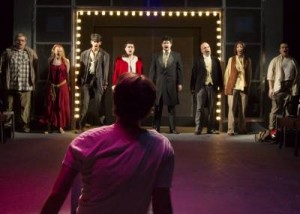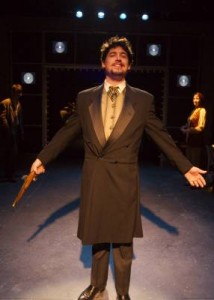
If by some chance you’ve never seen or heard of Stephen Sondheim and John
Weidman’s Assassins, here’s what it’s about, in brief:
It’s about eight men and women who either assassinated, or attempted to
assassinate, a United States President.
Not your usual bill of fare for a musical, is it?
And yet, despite its potentially gruesome and disturbing subject matter (and it
is at times both gruesome and disturbing), Assassins is often funny and always
involving, besides containing some of the most hummable tunes ever written
by a composer not known for his “hummability.”
Since Orange County’s award-winning Chance Theatre’s announcement
that its 2008 season would open with Assassins, Southern California Sondheim
fans have been wondering how Wunderkind Artistic Director Oanh Nguyen
would put his own original stamp on it.
Fans of both Sondheim and Nguyen will not be disappointed.
Never have Nguyen’s prodigious directorial talents been more evident than in
his brilliant re-imagining of Assassins.
Start with the most radical change. The cast has been cut from the 16
featured in the 2004 Broadway production down to 9, the Balladeer and the
eight Assassins. Gone are the Proprietor and the ensemble of 6, the Balladeer
and the Assassins assuming these actors’ roles.
Next is the radical reconfiguration of the Chance stage. The audience sits on
opposite sides of what would normally be the left and right walls, with four
empty front row seats on either side left empty for the Assassins to sit among
the audience at various intervals.
The stage has thus become a long, tunnel-like space separating one half of
the audience from the other, its two extremes designed to resemble a
shooting gallery with light bulbs flashing and bells ringing whenever an Assassin
hits a target.
Nguyen seems to be saying with these changes that these eight men and
women who either killed, or attempted to kill, our national leaders are at heart
no different from any of us, and as we watch the musical unfold, we cannot
help looking at each other at the same time as we are looking at the Assassins
and seeing in them (and in each other) a capacity for doing the unspeakable.
Nguyen’s Assassins begins with actor Paul Kehler (whom those who have seen
Assassins before might assume to be playing the Proprietor) singing the jaunty
“Everybody’s Got The Right,” as the eight Assassins enter one by one and join
in the rousing chorus. The Assassins take their front row seats, four on either side
as Kehler transforms himself into John Wilkes Booth, his leg bandaged and
bearing a crutch, the seated Assassins assuming the voices of characters
usually played by the ensemble.
In a tour de force performance, Kehler is such a passionate Booth that one
cannot help but feel for him and for his certainty that he was absolutely right
to kill the President responsible for causing so much loss of life.
Bob Simpson, dynamic as always in the role of the Balladeer, engages Booth in
“The Ballad of Booth,” accusing him of only wanting attention, and of having
inadvertently increased (in today’s idiom) Lincoln’s approval rating. “Because
of you he now gets only raves,” taunts the Balladeer.
The Assassins later assume the voices of onlookers to Giuseppe Zangara’s
attempted assassination of Franklin Delano Roosevelt, this following an
exchange representative of the sly humor in Weidman’s book. Zangara
complains to the Balladeer that nothing seems to cure his various physical
ailments, to which the Balladeer responds, “Have you considered shooting
FDR?” “Will that help?” asks a hopeful Zangara. “Well, it couldn’t hurt,” replies
the Balladeer. (The role of Zangara is brought to intense life by an excellent
Jara Jones, so real that it’s hard to believe this is an actor and not the genuine
article.)
In an interesting though not entirely successful twist, Booth also becomes
anarchist Emma Goldman, with his own southern drawl replacing Goldman’s
Eastern European accent, a twist that might prove bewildering to some.
One of the highlights of any production of Assassins is the hilariously kooky
conversation between crazy sexy bimbette Lynette “Squeaky” Fromme and
dorky Southern housewife Sarah Jane Moore, over a basket of Colonel
Sanders’ Kentucky Fried Chicken. Here, the scene is played to perfection by
Emily Clark and Allison Appleby, who later reveal themselves to be fine singers
as well as actress/comediennes.
Clark returns subsequently to sing one of the most gorgeous (albeit offbeat)
love songs in the Sondheim repertoire, “Unworthy Of Your Love” opposite
Daniel Berlin, doing touching work as a sad and pathetic John Hinkley.
Gorgeous and passionate acting and singing from both Clark and Berlin.
Tall, gangly David Lamoureux as Leon Czolgosz is another who totally
disappears into his role, demonstrating a beautiful singing voice as well.
Richard Comeau does equally fine work as Charles A. Guiteau, whose “The
Ballad of Guiteau” combines Broadway and Negro spiritual, all the while
Comeau’s eyes reflect the madness of his character.
Chance Theater regular Dimas Diaz dazzles as the craziest and most talkative
Assassin of them all, Samuel Byck, who dressed as Santa Claus goes on and on
in an extended, vulgar rant against Leonard Bernstein and Richard Nixon.
Those who complain that Sondheim’s melodies are too complex and atonal to
leave the theater humming should give another listen to “Another National
Anthem,” which sounds at times like a Jerry Herman show tune, and is
performed in rousing fashion by the eight Assassins. Then, in one of the show’s
most powerful and memorable scenes, the Balladeer assumes the persona of a
suicidal Lee Harvey Oswald, goaded by John Wilkes Booth into killing John F.
Kennedy instead of himself. Simpson and Kehler deserve highest praise for their
intense and committed work in this scene, which ends with the eight Assassins
telling Oswald, “Today we are reborn through you. With you we’re a force of
history.” Scary, upsetting, and powerful stuff.
Following the JFK assassination comes a song not in the original off-Broadway
production. In “Something Just Broke,” average Americans recall what they
were doing at the moment they heard the devastating news from Dallas. On
CD, this song seems out of place in a show where all the other songs came
from the point of view of the Assassins themselves. Not so in Nguyen’s
production. Because we have already seen the Assassins take on other
personas, it seems not at all incongruous when they become “us,” the
witnesses, the victims.
Carmen Cortez Dominguez deserves applause for her musical direction, a fine
example of which is “The Gun Song”’s exquisite four-part harmony, and the
outstanding work done by Robert Hilton and Rick Heckman on keyboards, and
Lonn Hayes on percussion.
Rarely has a set so clearly reflected a collaboration between a director and
designer in bringing the former’s vision to life. Joe Pew’s shooting gallery is
outwardly simple. Lightbulbs surround wide doors at either end of the stage,
and with TV monitors surrounding the lights. The monitors project John
MacDonald’s designs with images which illustrate Sondheim’s words and serve
to set scenes. There are targets, photos of Presidents, a desert highway, and
stacks of books representing the Texas School Book Depository where Oswald
lay in wait. There is also one particular projection onto Lee Harvey Oswald’s t-
shirt that is a feat of brilliant inspiration on Nguyen’s part and superbly
executed by MacDonald.
Dave Mickey’s sound and Erika C. Miller’s costumes are likewise first-rate, and
Glenda Morgan Brown deserves credit for coaching the actors in their various
regional and foreign accents.
Those who have never seen a production of Assassins before are in for an
exciting discovery at the Chance. Those who’ve seen other productions, no
matter how fine, are in for an even bigger treat. With its innovations and
surprises galore, this is the Assassins by which future productions will be
measured.
Chance Theatre, 5552 E. La Palma Avenue, Anaheim Hills.
www.chancetheater.com
–Steven Stanley
February 10, 2008
Photos: Doug Catiller




 Since 2007, Steven Stanley's StageSceneLA.com has spotlighted the best in Southern California theater via reviews, interviews, and its annual StageSceneLA Scenies.
Since 2007, Steven Stanley's StageSceneLA.com has spotlighted the best in Southern California theater via reviews, interviews, and its annual StageSceneLA Scenies.







 COPYRIGHT 2024 STEVEN STANLEY :: DESIGN BY
COPYRIGHT 2024 STEVEN STANLEY :: DESIGN BY